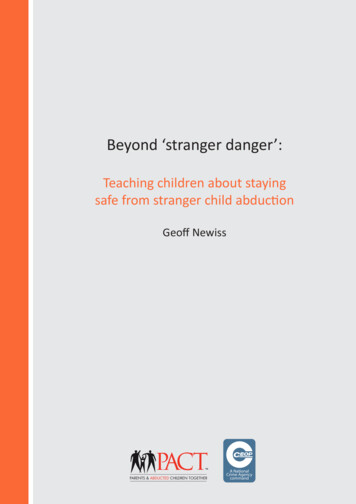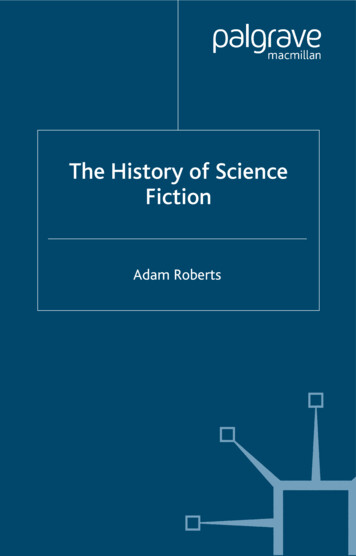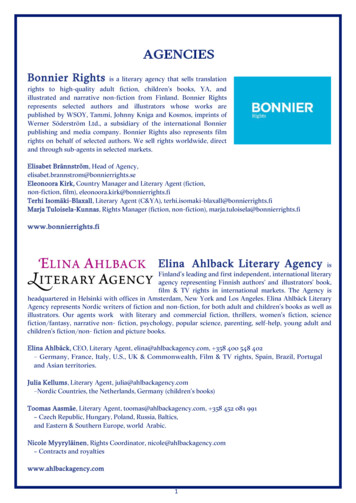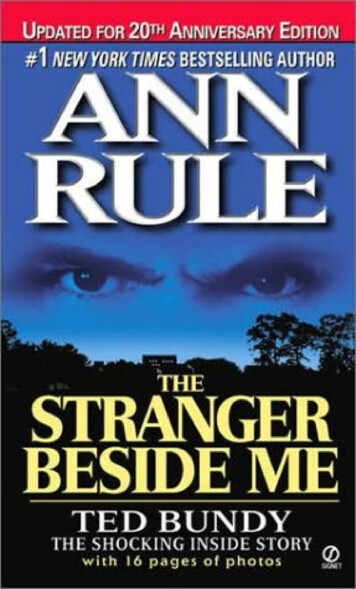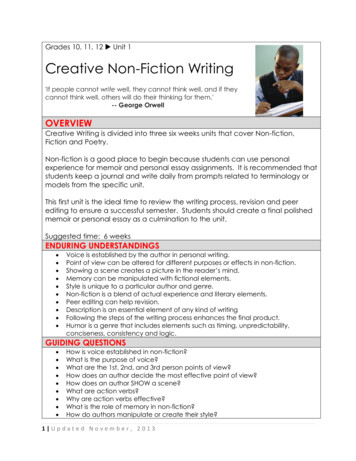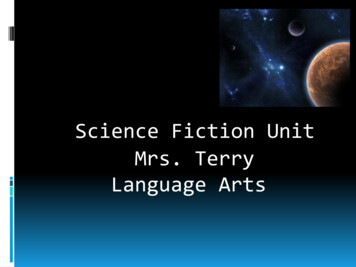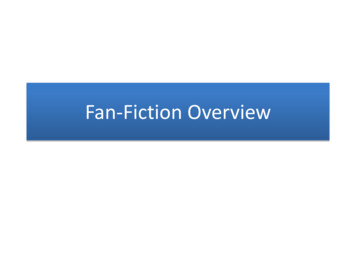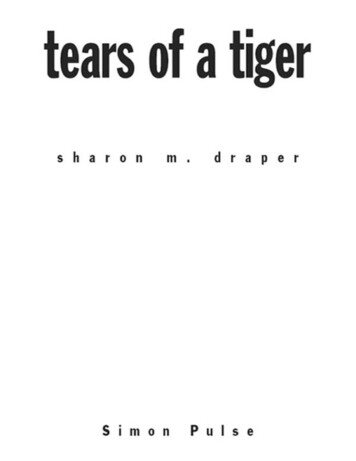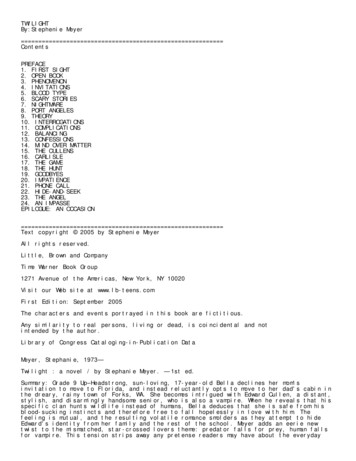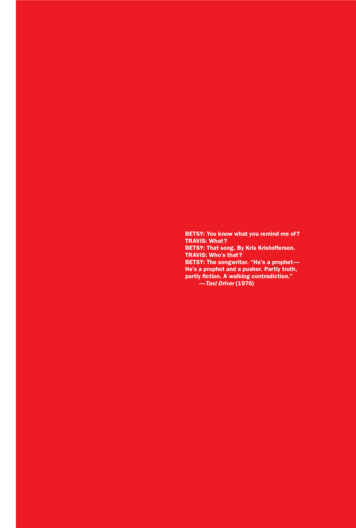
Transcription
BETSY: You know what you remind me of ?TRAVIS: What?BETSY: That song. By Kris Kristofferson.TRAVIS: Who’s that?BETSY: The songwriter. “He’s a prophet—He’s a prophet and a pusher. Partly truth,partly fiction. A walking contradiction.” —Taxi Driver (1976)
STRANGER212STRANGER THAN FICTIONDavid Lynch, EraserheadDan Clowes, Like a Velvet Glove Cast in Iron
stranger than fiction213THANFICTIONThe time has come when the normal revolt against time, space and matter must assume a formnot overtly incompatible with what is known of reality— when it must be gratified by images forming supplements rather than contradictions of the visible and measurable universe. And what, ifnot a form of non-supernatural cosmic art, is to pacify this sense of revolt— as well as gratify thecognate sense of curiosity?— H.P. Lovecraft in a letter to Frank Belknap Long (Feb 22, 1931)I vividly remember the first time I saw TwinPeaks. It was December 12, 1990. I was aneighth-grader growing up in the rural CascadeMountain town of Enumclaw, Washington.That night I was babysitting for our locallibrarian, Bob Baer. While under no circumstance would I have been allowed to watchTwin Peaks at home, I was free to be luredinto the series at the Baer residence withmy parents miles away and the kids asleepupstairs. Twin Peaks was a revelation. Notonly did it connect with me geographically,but creatively as well. Even the nonsensemade sense to me somehow. And that fascinated me. How could Lynch communicate soeffectively, while being so strange?At that age storytelling had alreadybecome an obsession of mine. I began writingand illustrating comic books in the fourthgrade, and by the eighth grade it consumedall the free time I had. At first I was apingthe style of the Marvel comics I loved, usingthe Stan Lee model of taking normal, flawedpeople and endowing them with superhumanpowers. I was interested in creating narrativesand places that were fictional yet believable,and after seeing Twin Peaks I realized thepotential of taking that model even further,and never saw storytelling the same again.As I grew older I began creating comicswith more complex assemblages of interestand influence. My latest series, Runoff, is anhomage to Enumclaw made from a surrealpastiche of elements: film noir, B-Horror,Bloom County, and Twin Peaks. While creating Runoff, I came to realize the same pointLovecraft makes in the beginning quote: Youwant to create something that revolts againstreality? Something memorable? Somethingsurprising? Then start with something that iscompatible with reality. Our reality: a placedepicted by naturalistic description andgoverned by common sense. And from theretransform it within that reality. And thenthere is a good chance you will have createdsomething that is at first approachable, thencurious, then fascinating and then maybeeven transcendent surreal uncanny.I adhere to this way of working both asa comic book creator and graphic designer:a way that creates work that roots itself inreality in order to subvert it. What is “real” iswhat is experienced communally, and if mywork can connect with that, then it will help
214Kasimir Malevich, Black SquareEdward Hopper, House by the RailroadDiane Arbus, Identical Twins, Roselle NJ, 1967Ralph Eugene Meatyard, Romance (N.) From Ambrose Bierce #3STRANGER THAN FICTIONwiden my audience and provide them with amore engaging, lasting experience.Striving to tap into what is collectivehas been a goal for a variety of artists, andthat has generated a variety of tactics toachieve that goal. On one end of the spectrum we find Kasimir Malevich, the fatherof the art movement Suprematism thatflourished around 1915 in Soviet Russia. Byrejecting the depiction of anything naturalistic or cultural, Malevich painted abstractgeometric compositions that strove to createshapes and spaces only possible in the imagination of humanity. Malevich stripped historical baggage and invited a new beginning forpainting through the erasure of representation. This tactic appealed to many creators,fully blossoming in the Modernist movement,where creators of all types — from paintersto architects — imagined a world free of ornament and history, a world bound by reasoninstead of reference, and therefore tappinginto a timeless collective imagination?At the other end of this spectrum wefind David Lynch, who evokes the communalthrough genre and cultural references. Ifind this tactic to be more effective becauseLynch embraces and uses reality in orderto transcend it. He takes our cultures, ourgenres, and subverts them, redirects them.In this way, Lynch’s tactics fit the Lovecraftian model of creating supplements to “thevisible and measurable universe” rather thancontradictions.Lynch’s redirection of expectation andgenre has an American accent, since American culture is often typified as a sampling andappropriation of other cultures. Here we stillfind the pioneer spirit, one that creates with abold lawlessness, an “anything goes” mentality. This spirit invites us to look at our world,our cultures, as fertile sources for referenceand inspiration.The transformative qualities I find affinity with in the work of Lovecraft and Lynch arepart of a tradition in American art and culture,one which I would describe as a loose hybridof odd references from horror fiction, fine art,and Americana; a kind of Gothic AmericanSurrealism.What’s this tradition about? It’s aboutunveiling the gothic in the everyday. It’s aboutemphasizing the grotesque and mysteriousqualities of something we could find on ourown block. It’s about knowing that the mostpowerful things can also be the most communal. It’s about borrowing from the mostfamiliar genres and icons to reveal the deeplyingrained and disturbing power of things thatwe might usually find comfort in. It’s about theuse of narrative and archetypical characters,and being innovative with the use of both.
stranger than fictionLike a creature without a fixed form,the tradition of Gothic American Surrealismcan be found in a variety of art. It can befound in the writings of Edgar Allen Poe, H.P.Lovecraft, Patricia Highsmith, Stephen King,and Cormac McCarthy. It can be found inthe photographs of Diane Arbus, O. WinstonLink, and Ralph Eugene Meatyard. The musicof Brian Wilson, DEVO, Warren Zevon, andDJ Shadow. The films of Alfred Hitchcock,Stanley Kubrick, Tim Burton, and the CoenBrothers. The comics of Winsor McCay, JackKirby, Berke Breathed, and Dan Clowes. Theart of Edward Hopper, Charles Sheeler, PaulMcCarthy, Eric White, and John Currin.This tradition not only manifests itselfacross a variety of media, it also has a tradition of inspiring and cross-referencing itselfamong those media. With its high contrastand open composition, Edward Hopper’s 1925painting House by the Railroad invites meto imagine exactly why I wouldn’t want toknock on that door. Alfred Hitchcock seemedintrigued to knock, and gave us the BatesMotel and Psycho in 1960. Diane Arbus’ Identical Twins, Roselle NJ, 1967 was twinneditself in 1980 when we laid eyes on the twingirls haunting the halls of the Overlook Hotelin Stanley Kubrick’s The Shining, which isitself based on the novel of another practitioner of Gothic American Surrealism: StephenKing. The mundane yet ominous landscapeand lighting of David Lynch’s 1977 film Eraserhead was a clear influence on Dan Clowes’early ’90s surreal comic book masterpieceLike a Velvet Glove Cast in Iron. And a phraseuttered by The Giant in Lynch’s Twin Peaks issampled to close DJ Shadow’s groundbreaking 1996 album Endtroducing. This sampleShadow chose is quite fitting for the tradition.“It is happening again” the Giant says “It ishappening again.”Gothic American Surrealism also knowsthe power of reviving and re-appropriatingthings of the past. The tradition embraceshauntology, an idea first introduced byJacques Derrida’s in his 1994 work Spectersof Marx. The Wikipedia entry for hauntologyexplains the idea quite well:The word, a portmanteau of haunt andology and homophone to ontology inDerrida’s native French, deals with “theparadoxical state of the spectre, whichis neither being nor non-being”, according to a professor at RMIT University.The idea suggests that the presentexists only with respect to the past, andthat society after the end of history willbegin to orient itself towards ideas andaesthetics that are thought of as rustic,bizarre or “old-timey;” that is, towardsthe “ghost” of the past. In this, it is has215David Lynch, Twin PeaksAlfred Hitchcok, PsychoStanley Kubrick, The ShiningPaul McCarthy, Bossy Burger
216STRANGER THAN FICTIONsome similarity with the cyberpunk literary movement.Hauntology is proving to be quiterelevant for today, with the use of samplingpermeating all forms of contemporary art.Currently the idea finds its biggest supporterin the critic Simon Reynolds, who, in his 2006essay Hauntology Now, states:Why hauntology now? Well, has thereever been a time when finding gaps in theseamless surfaces of ‘reality’ been morepressing? Excessive presence leavesno traces. Hauntology’s absent present,meanwhile, is nothing but traces.Graphic design is almost by definitiona practice based around the collection andre-presentation of things. And the flexibility ofGothic American Surrealism across a varietyof media makes its translation into a formalgraphic language for a designer like myselfquite appealing.Graphic design is a protean profession, one that morphs through various formsand media to express content. In BeatriceWarde’s classic 1955 essay The CrystalGoblet, she argues that a true typographerstrives to become invisible in the presentationof content, just as wine is best experiencedin a clear crystal goblet. Warde believes atypographer should only make decisions thatbest present the color, character, and flavorof the subject at hand. In a sense I agree withWarde, for I often look at a design problem byimagining what decisions I can make to bestamplify the characteristics I find interestingin the content. But my presence as a designerrecedes not from a scarcity of graphic elements, but from a multitude of graphic styles.In other words, my voice as a designer isn’tpresent because it is mute; but insteadbecause it is speaking in many tongues.When presented with a subject for adesign piece, I investigate and imagine wherethe subject at hand comes from. What context or character is inherent to it. Then I beginto transform it. And while I am not a designerwho adheres to a single formal agenda, I ama designer who adheres to a set of tacticalagendas. These tactical agendas strive torecharge context by adding something engaging, something surprising. And it is throughthese tactical agendas that a body of designwork emerges that may have variety, butshares a signature core all my own. And thesetactics I adhere to are the use of redirection,genre, and the truth.A well-executed redirection is a powerful tactic for designers, and I feel I use itoften because of my background as a comicbook illustrator and writer. In that profession,both pacing and the right twist at the rightmoment is everything.Redirection is required for almost anyengaging constructed experience. Imagine amovie about a man who gets up in the morning, experiences a predictable day, and thengoes to bed. Roll credits. That wouldn’t cut it.As an audience, we expect a deviation fromthe expected to happen at some point—though it is the power and placement of thatdeviation that can make it, or break it.Scary stories are short masterpieces atthis. A babysitter starts getting scary phonecalls. The calls keep coming. Calls promisingto kill the babysitter and the kids. Finally, thebabysitter asks the operator to trace the lastcall. And the operator states in bewilderment“the call is coming from inside your house!”Everyone knows that one. A quick, effectiveredirection sticks with us. It enters our collective discourse.An example of using redirection effectively in my work is a motion graphics biography I did about my classmate Daniel Harding.It begins with a white background, with Danplaced in the lower left of the screen. Textscrolls quickly from the bottom, to come torest at the upper right of the screen. “This isDaniel Harding,” it reads. Dan reads the text,and begins to disagree with the statement.“Eh,” he says, “actually, um ” but beforehe can finish, the text rewrites itself to read“This is Daniel Joseph Harding.” Dan readsthe edit and says “Okay.”Redirection one: Dan can somehowdisagree with the text, and it immediately corrects itself without Dan having to be specificon what is wrong with it.The text then scrolls off screen, and isreplaced by a new statement, which reads“He is your typical mild-mannered gentlemanfrom a suburban London town.” Dan seesthe new text and says “Oh, I also lived in ehm ” and the text immediately changes toadd “and Saudi Arabia.” Dan reads the editand says “Okay.”Redirection two: Dan’s past is a bit moreexotic than you may have originally thought.A few more of these interactions happenbetween Dan and the text, forming a paceand tone. The viewer expects text to scrollup from the bottom, expects Dan to disagreewith it, and expects the text to rearrangeitself to better reflect the character of Dan. Itis quiet and cordial. Then a line of text scrollsup which states “He likes bands like SonicYouth and Pavement.” Nothing strange here,the sort of smart art-rock bands liked by manydesigners. Dan nods, suddenly perks up, saying “Oh! And Megadeth.”Megadeth’s 99 Ways to Die comes thundering in with a heavy metal assault. Imagesof Megadeth’s skeleton mascot Vic Rattlehead leap up one at a time to the pounding
stranger than fiction217This is Daniel Hardingbeat. And Dan sits and stares at us, lost inthe sudden saturation of image. The white,flat world of typography and interaction weexperienced before has been replaced by asurreal space populated by heavy metal monsters, nearly obliterating the small Englishman in the corner.Redirection three: the environment,both sonically and visually, has been totallyoverturned. And if it wasn’t apparent before,it is apparent now that the text and imagesare being projected onto Dan instead of somepost-production trick. This sudden assault isonly effective because of the previous timespent creating a quiet, predictable environment. The bio piece is a set of small redirections followed by a major one. And it’s alldone in thirty seconds.Another tactic is the use of genre. Talkabout getting bang for your buck: genrescome prepackaged with associations andexpectations that can be played upon toamplify your subject at hand. Reality isoften characterized through the communallanguage of genre —“it was like a horrormovie”— since genres are often reality in ahighly concentrated form. In this way genresare like potent flavors: using combinationsand dashes of them together will createsomething more engaging and surprisingthan sticking with the overwhelming flavor ofjust one.After being assigned to make a public service announcement of our choice, Idecided to create a motion graphics piecethat addressed a fictional social problem:the chronic misuse of a powerful magichand sign called Nebiros. The narrator ofthe piece informs us that although usingNebiros is quite effective, it “Weakens transdimensional steady states making our planesusceptible to Roanoke Island Phenomenon.”He then goes on to present us with a set ofscenarios, asking whether they would beappropriate for Nebiros usage: “Would itbe proper to use it to alter a 10-level hypercube?” (YES!) “What about to find your TVremote?” (NO!) “What about to banish a levelseven demon?” (NO!) “How about to completeyour taxes?” (YES!)Using Nebiros began by citing namesand warnings found in books on the occult,especially those addressing the practicesof occultists such as Aleister Crowley. But Iwrote the copy to be reminiscent of educational films from the 1950s. And the visualelements were based not on the dark, druidicstyle associated with the occult, but insteadon Japanese cartoon commercials. Thegenre of Japanese commercials, which often
218STRANGER THAN FICTIONUsing Nebirosincludes a cute cartoon narrator, locks inwell with the genre of American educationalfilms, which often used the same narrativetrope. And so, in this bright and poppy landfilled with pinks and cyans, your narratorcomes in the form of a cute floating cartoonhead that looks like a mustached robot wearing a turban, and speaks in a raspy, upperclass British accent.In the end Using Nebiros is a mixture ofat least three genres: a 1950s American educational video discussing the occult powerof the hand symbol Nebiros in the visuallandscape of Japanese product commercials.This strange mixture is a good example of mydesign process: I took my idea and homedin on the moods, elements, and genres thatwould provide the best surprises, combinations, and solutions to make that idea evenmore engaging.Using contradictory genres togetherhas been a favorite tactic of mine in both mydesign and comic book work. The question ofwhich genre a project should evoke, or whichones it should contrast within itself, is oneI approach at the beginning of each project.This is a tactic used by others working in thetradition of Gothic American Surrealism. Stanley Kubrick has always been an inspiration forme in this regard, especially his decisions inthe making of the 1964 film Dr. Strangelove.The book that it is based on, Red Alertby Peter George, is a straightforward, TomClancy-esque thriller, and Kubrick found it difficult to adapt successfully. That is, until hedecided to make this chilling tale abouta nuclear apocalypse into a comedy. And onehell of a comedy at that— it is now hailedby many critics as the best in cinema history.What makes Dr. Strangelove so effective isthe powerful contrast between the subjectmatter and the genre through which itis delivered.But my most used, most signature tacticis to take what I find most fascinating aboutour reality, about what is true, and allow thattruth to be presented in a way that baffles.Knowing when to leave the truth as justthat is a very powerful tactic for a designer,because truth is stranger than fiction. Manyof my projects present aspects of our worldunaltered, and they often prove to be themost engaging pieces.I recounted the 1971 meeting betweenElvis Presley and then President RichardNixon in a sixteen-page book using onlydocuments and photos from that event. Inthe process of making it, my initial impulsewas to begin overlapping and affecting theimages. Karel Martens was visiting Yale at
stranger than fiction219For/Getthe time and pointed out that the book wouldbe stronger by altering nothing, since theuntouched images were surreal enough ontheir own. That served as a key lesson for me,one that I have used in many other projects.In each of the three For/Get books Idesigned, I reprinted a leaked talking pointpaper written by the political strategist FrankLuntz for the George W. Bush administration.These papers (one on the war on terror, oneon the Israeli-Palestinian conflict, and oneon the environment) are filled with Orwellianlanguage such as “Americans are willingto accept sacrifice if it is in the cause offreedom and security.” These Luntz papersare terrifying in their frank belief that theAmerican public can be talked into anythingas long as one uses “words that work,” suchas naming a bill stripping citizens rights “ThePatriot Act,” or a law opening up our foreststo more aggressive logging “The HealthyForests Initiative.”In these booklets I reprint the Luntzdocuments in full, and inset them betweentwo larger pages that have various AssociatedPress photographs relevant to the subject.To top it off, each inset portion of the Luntzdocuments open to reveal a pull quote that Ihave chosen to best highlight the frighteningand manipulative language found within. Boththe text and photos are real and unedited,though the way they interact leads to a senseof disbelief that our government is really operating in such a way.A final example of using truth to baffleis what I call my Duncan book. The book isabout the Duncan Hotel in New Haven, and isdivided into chapters that address differentaspects of the hotel. Within each chapterthe subject, tone, layout, and paper stockchange, creating a cast of characters andsubjects bound within the spine of a singlebook, similar to the strange collection ofpeople and situations found within the hotelon any given night.The book begins by reprinting customerreviews of the Duncan found online throughplaces like Trip Advisor and Yahoo, whichare startling in the sheer horror so manyfelt while staying there. These reviews aremixed in with photographs I took of thehotel lobby, a strange and creepy place thatseems lost in time. This first chapter endswith a text written by John Hinckley on NewYear’s Day, 1981. Hinckley, obsessed withthe movie Taxi Driver, was a resident of theDuncan hotel while he stalked Jody Foster,before his assassination attempt on RonaldReagan. After Hinckley’s New Year’s entry, anew chapter begins, reprinting the poetry of
220STRANGER THAN FICTIONSpam CollaborationsHinckley paired with images of White Housedocuments recounting the Reagan assassination attempt. After this chapter on Hinckley,a new one begins consisting of portraits andstories of current residents of the Duncan.The final chapters document the night Ichecked into the Duncan myself to record myown experiences.Each chapter, each photo, each piece oftext, is true. But the real characters and stories surrounding the Duncan create a surrealand potent atmosphere. And the best partabout it is that, when questioned, you can saywith full confidence that everything within itis true, that this is reality.More often than not, my work is generated through a mixture of these three tactics.Two examples of this are among my strongestpieces of design work: The Spam Book, andThe Parking Garage Movie.The Spam Book was the last in a seriesof pieces I made around the theme of transformation. One day a spam email caught myeye. It was one of those that used computergenerated gibberish to get through my spamfilters and into my inbox. The text was vividlypoetic and it sparked an idea. I decided Iwould choose one spam email a day as a pieceof copy submitted by a writer wanting to collaborate with me as a comic book illustrator.In this spam collaboration I decidedthe subject of the email would serve as thetitle of the comic strip, the computer generated name of the spam emailer would be thename of the writer, and I would transform theabstract spam text into either a one panelcomic strip (such as the Far Side or FamilyCircus) or four panel comic strip (such asGarfield or Doonesbury ). At the top of eachcomic strip would be the date the text wassubmitted, and that could serve as a reference for the back portion of the book wherethe original spam text would be reprinted.I wanted to execute these collaborationsin the style of daily comic strips becauseit evokes a genre known for its bland simplicity, something that— with only a fewexceptions — plays to the lowest-commondenominator and rarely challenges its audience. It is a genre with a commonly understood structure, one that is expected bynearly everyone (panel one: the set up, paneltwo and three: the build, panel four: the joke).So it is the perfect genre to pair with textsso wildly abstract, texts created without anynarrative structure in mind. I also utilized thewide variety of sub-genres inherent to thedaily comic strip by changing the drawingstyle for each comic to reflect the characterand atmosphere I found in the spam text.
stranger than fictionFor the Spam Book, the tactical use ofthe truth was using the text, date, subjectand name of the spammer. The tactical useof redirection was to take that spam text andimagine it as a piece of copy submitted forcollaboration. The tactical use of genre wasto choose the format of a daily comic bookstrip.My Parking Garage Movie originatedfrom an assignment asking for two piecesbased around a site of our choice. My firstpiece was a book that dealt with the constants and variables of the parking garage.For the second piece I wanted to do theopposite: a movie that dealt with narrativeand atmosphere. I decided on the genre first.I wanted to make a horror movie using onlythe spaces and sounds of the parking garage.No people. No words. This genre came to mindbecause of the many times films use an emptyparking garage as an ominous place. If youare watching a movie and someone is walkingalone to their car in a parking garage youknow something bad is about to happen.I went into the garage and investigatedwhat elements I could activate and use. Thedoors to the stairwells. The elevators. Thesecurity camera feeds. The mechanized entrygates. I made audio recordings of the spaceto capture the range of sounds available tome in that space. The sudden eruption ofsounds when an elevator arrives. The mechanical hum of the entry gates. The ghostly echoof a car on a higher floor. After exploring whatthe space could provide, I created an abstractnarrative around what I could gather, andthen recorded the visuals and sounds that Ineeded.Next I mined the recordings to beginconstructing the narrative and atmosphere Ienvisioned. I edited and sequenced the videofootage, sometimes manipulating the flowof time. I played with the audio recordings,enhancing and isolating qualities I foundwithin them. Finally I paired the two together.I redirected the true sounds and movement ofthe space to create a movie that slowly introduces a parking garage seemingly haunted bypoltergeists running wild, chasing each other,evoked through the activation of the spacesfound within the parking garage.For the Parking Garage Movie the tactical use of the genre came first by decidingto play off the ominous atmosphere parkinggarages so often have in cinema. The tactical use of the truth was the decision to havethe movements and sounds provided by thegarage be the only characters used. Andthe tactic of redirection came through theediting, sequencing, and manipulation of thatfootage to get the atmosphere and narrativeI had set out to create. And the atmosphere221Parking Garage Movie
222STRANGER THAN FICTIONOverlook Hotel, July 4th Ball, 1921 from The ShiningI wanted was one that I have often striven tocreate: that of the uncanny.In the book Film Art, the authors DavidBordwell and Kristin Thompson discuss various abstract formal systems in cinema. Oneapproach they put forth “is to use real objectsand to isolate them from their everyday context in such a way that their abstract qualities come forward.” That is what the ParkingGarage movie does: it takes the real qualitiesinherent to that space, and uses them in acalculated way to transcend reality. As viewers we can’t help but to assign a personalityto this lifeless, yet animated parking garage.This fits into Ernst Jentsch’s 1906 definitionof the uncanny, in which one “doubts whetheran apparently animate being is really alive; orconversely, whether a lifeless object mightbe, in fact, animate.”Jentsch’s definition of the uncanny wascentral to Freud’s seminal 1919 essay on thesubject. In Das Unheimliche (The Uncanny ),Freud categorizes the phenomenon of theuncanny as belonging not to the realm of thepsychological, but to the aesthetic. This isan important distinction, and Freud lamentsthe lack of exploration and writing on theuncanny:As good as nothing is to be found uponthis subject in comprehensive treatiseson aesthetics, which in general preferto concern themselves with what isbeautiful, attractive and sublime; thatis, with feelings of a positive nature; andwith the circumstances and the objectsthat call them forth, rather than withthe opposite feelings of repulsion anddistress.Freud goes on to build upon Jentsch’sdefinition of the uncanny, saying it residesin places where “the distinction betweenimagination and reality is effaced, as whensomething we hitherto have regarded asimaginary appears before us in reality.” Freudstates that the experience of the uncannyis to feel as if one is “being robbed of one’seyes,” and that instances of “repetition of thesame thing” evoke the uncanny.In an example tying together the idea ofbeing robbed of one’s eyes and experiencingrepetition, Freud presents a scenario in which“one may wander about in a dark, strangeroom, looking for the door or for an electricswitch, and collide time after time with thesame piece of furniture.” I took this scenarioas inspiration for a short motion piece I madeabout the Duncan hotel. In this movie youexperience a slow pan of the bathroom in aDuncan hotel room, though the pan is unevenin pace and at times jostled. You hear a con-
stranger than fiction223stant gurgling and hissing from the leakingtoilet. And at times the room seems to foldupon itself, covering exits and spaces withwalls and doors. After about a minute the panhas circled itself, and you realize you are backat the beginning again, and the loop continues infinitely.The aesthetic phenomenon of theuncanny is extremely hard to evoke, but has apower to engage and surprise that fascinatesme as both a graphic designer and storyteller. It is, like hauntology, an idea that hasrenewed relevance in the cultural landscapewe find ourselves in today. Hauntology andthe uncanny have much in common. “Hauntis a perfectly uncanny word,” states SimonReynolds “since like ‘unheimlich’ it connotesboth the familiar-domestic and its unhomelydouble. Haunt originally meant ‘to providewith a home,’ and has also carried the senseof the ‘habitual.’”Both the uncanny and hauntology relateto our contemporary experience because welive in a culture based heavily on samplingand constructed realities. A drum breakfrom James Brown’s Funky Drummer hasbeen looped not just for one hip-hop recording, but for literally hundreds. Fred Astairehas returned from the grave to dance with avacuu
STRANGER THAN FICTION strANGer tHAN FictioN 213 i vividly remember the first time i saw Twin Peaks. it was December 12, 1990. i was an eighth-grader growing up in the rural cascade Mountain town of enumclaw, Washington. that night i was babysitting for our local librarian, Bob Baer. While
